Investigating the Impact of the Spatiotemporal Bias Correction of Precipitation in CMIP6 Climate Models on Drought Assessments
Abstract
1. Introduction
2. Materials and Methods
2.1. Study Area
2.2. Data Source
2.3. Methods
2.3.1. Histogram Matching-Quantile Mapping Correction
2.3.2. Drought Assessment
2.3.3. Correlation, Trend Analysis
3. Results
3.1. Proof of Spatiotemporal HQ-Corrected Method Effectiveness
3.2. Quantifying the Impact of Precipitation and PET Correction on Drought Projection
3.3. Future Trend Changes and Significance of Precipitation, PET, and SPEI
4. Discussion
4.1. The Impact of Precipitation and PET Correction on Drought Assessment
4.2. The Relationship between Future Precipitation, PET, and SPEI Changes
4.3. Limitation and Future Research
5. Conclusions
- (1)
- The spatiotemporal HQ correction approach may successfully increase the simulation accuracy of the integrated model using the Taylor diagram and spatiotemporal analysis. The correlation with observed precipitation rose from 0.237 (p = 0.058) to 0.638 (p = 1.118 × 10−8) when compared with QM correction, and the correlation with observed PET increased from 0.286 (p = 0.021) to 0.919 (p = 3.529 × 10−27).
- (2)
- The change of drought intensity over the QHTP in the future is mainly controlled by precipitation correction, with the area accounting for 85.422%. The average annual total precipitation in the 99.952% region declined by 64.262% and the average annual total PET in the 11.902% area had a rise of 5.881%, and the 88.098 regions saw a loss of 10.861% with HQ correction. When fundamental factors were corrected, the intensity of a single drought event rose in the 81.331% region by 2.875% and dropped in the 18.669% area by 1.139%.
- (3)
- The original ensemble model overestimates the increasing trend of precipitation and underestimates the decreasing trend in SPEI in three future scenarios. The rate of precipitation growth increases from 7.594 mm/10a, 15.017 mm/10a, and 27.377 mm/10a to 3.730 mm/10a, 7.190 mm/10a, and 12.790 mm/10a after HQ correction, correspondingly. The downward trend in SPEI changed from 0.047/100a, −0.056/10a, and −0.133/10a to −0.143/100a, −0.397/100a, and −0.6675/100a.
Supplementary Materials
Author Contributions
Funding
Data Availability Statement
Acknowledgments
Conflicts of Interest
References
- Solomon, S.; Qin, D.; Manning, M.; Averyt, K.; Marquis, M. Climate Change 2007—The Physical Science Basis: Working Group I Contribution to the Fourth Assessment Report of the IPCC; Cambridge University Press: Cambridge, UK, 2007; Volume 4. [Google Scholar]
- Trenberth, K.E.; Dai, A.; Van Der Schrier, G.; Jones, P.D.; Barichivich, J.; Briffa, K.R.; Sheffield, J. Global warming and changes in drought. Nat. Clim. Chang. 2014, 4, 17–22. [Google Scholar] [CrossRef]
- Arias, P.; Bellouin, N.; Coppola, E.; Jones, R.; Krinner, G.; Marotzke, J.; Naik, V.; Palmer, M.; Plattner, G.-K.; Rogelj, J. Climate Change 2021: The Physical Science Basis. Contribution of Working Group14 I to the Sixth Assessment Report of the Intergovernmental Panel on Climate Change; Technical Summary; 2021. Available online: https://www.ipcc.ch/report/sixth-assessment-report-working-group-i/ (accessed on 15 August 2022).
- Gu, L.; Chen, J.; Yin, J.; Xu, C.Y.; Zhou, J. Responses of precipitation and runoff to climate warming and implications for future drought changes in China. Earth’s Future 2020, 8, e2020EF001718. [Google Scholar] [CrossRef]
- Yong, Z.; Xiong, J.; Wang, Z.; Cheng, W.; Yang, J.; Pang, Q. Relationship of extreme precipitation, surface air temperature, and dew point temperature across the Tibetan Plateau. Clim. Chang. 2021, 165, 41. [Google Scholar] [CrossRef]
- Ukkola, A.M.; De Kauwe, M.G.; Roderick, M.L.; Abramowitz, G.; Pitman, A.J. Robust future changes in meteorological drought in CMIP6 projections despite uncertainty in precipitation. Geophys. Res. Lett. 2020, 47, e2020GL087820. [Google Scholar] [CrossRef]
- Huang, D.Q.; Zhu, J.; Zhang, Y.C.; Huang, A.N. Uncertainties on the simulated summer precipitation over Eastern China from the CMIP5 models. J. Geophys. Res. Atmos. 2013, 118, 9035–9047. [Google Scholar] [CrossRef]
- Chai, Y.; Yue, Y.; Slater, L.J.; Yin, J.; Borthwick, A.G.; Chen, T.; Wang, G. Constrained CMIP6 projections indicate less warming and a slower increase in water availability across Asia. Nat. Commun. 2022, 13, 4124. [Google Scholar] [CrossRef] [PubMed]
- Ficklin, D.L.; Abatzoglou, J.T.; Robeson, S.M.; Dufficy, A. The influence of climate model biases on projections of aridity and drought. J. Clim. 2016, 29, 1269–1285. [Google Scholar] [CrossRef]
- Johnson, F.; Sharma, A. What are the impacts of bias correction on future drought projections? J. Hydrol. 2015, 525, 472–485. [Google Scholar] [CrossRef]
- Cannon, A.J.; Sobie, S.R.; Murdock, T.Q. Bias correction of GCM precipitation by quantile mapping: How well do methods preserve changes in quantiles and extremes? J. Clim. 2015, 28, 6938–6959. [Google Scholar] [CrossRef]
- Piani, C.; Weedon, G.; Best, M.; Gomes, S.; Viterbo, P.; Hagemann, S.; Haerter, J. Statistical bias correction of global simulated daily precipitation and temperature for the application of hydrological models. J. Hydrol. 2010, 395, 199–215. [Google Scholar] [CrossRef]
- Gudmundsson, L.; Bremnes, J.B.; Haugen, J.E.; Engen-Skaugen, T. Downscaling RCM precipitation to the station scale using statistical transformations–a comparison of methods. Hydrol. Earth Syst. Sci. 2012, 16, 3383–3390. [Google Scholar] [CrossRef]
- Song, Z.; Xia, J.; She, D.; Li, L.; Hu, C.; Hong, S. Assessment of meteorological drought change in the 21st century based on CMIP6 multi-model ensemble projections over mainland China. J. Hydrol. 2021, 601, 126643. [Google Scholar] [CrossRef]
- Sian, K.T.C.L.K.; Hagan, D.F.T.; Ayugi, B.O.; Nooni, I.K.; Ullah, W.; Babaousmail, H.; Ongoma, V. Projections of Precipitation Extremes based on Bias-corrected CMIP6 Models Ensemble over Southern Africa. Int. J. Climatol. 2022, 1–21. [Google Scholar] [CrossRef]
- Ngai, S.T.; Juneng, L.; Tangang, F.; Chung, J.X.; Salimun, E.; Tan, M.L.; Amalia, S. Future projections of Malaysia daily precipitation characteristics using bias correction technique. Atmos. Res. 2020, 240, 104926. [Google Scholar] [CrossRef]
- Tong, Y.; Gao, X.; Han, Z.; Xu, Y.; Xu, Y.; Giorgi, F. Bias correction of temperature and precipitation over China for RCM simulations using the QM and QDM methods. Clim. Dyn. 2021, 57, 1425–1443. [Google Scholar] [CrossRef]
- Nahar, J.; Johnson, F.; Sharma, A. Addressing spatial dependence bias in climate model simulations—An independent component analysis approach. Water Resour. Res. 2018, 54, 827–841. [Google Scholar] [CrossRef]
- Hannachi, A.; Jolliffe, I.T.; Stephenson, D.B. Empirical orthogonal functions and related techniques in atmospheric science: A review. Int. J. Climatol. A J. R. Meteorol. Soc. 2007, 27, 1119–1152. [Google Scholar] [CrossRef]
- Yu, H.; Zhang, Q.; Wei, Y.; Liu, C.; Ren, Y.; Yue, P.; Zhou, J. Bias-corrections on aridity index simulations of climate models by observational constraints. Int. J. Climatol. 2022, 42, 889–907. [Google Scholar] [CrossRef]
- Nanjegowda, R.A.; Parambath, S.K. A novel bias correction method for extreme rainfall events based on L-moments. Int. J. Climatol. 2022, 42, 250–264. [Google Scholar] [CrossRef]
- Hannachi, A. Regularised empirical orthogonal functions. Tellus A Dyn. Meteorol. Oceanogr. 2016, 68, 31723. [Google Scholar] [CrossRef]
- Yan, Y.; Yang, Z.; Liu, Q. Nonlinear trend in streamflow and its response to climate change under complex ecohydrological patterns in the Yellow River Basin, China. Ecol. Model. 2013, 252, 220–227. [Google Scholar] [CrossRef]
- Saidi, H.; Dresti, C.; Manca, D.; Ciampittiello, M. Quantifying impacts of climate variability and human activities on the streamflow of an Alpine river. Environ. Earth Sci. 2018, 77, 690. [Google Scholar] [CrossRef]
- Mondal, S.K.; Tao, H.; Huang, J.; Wang, Y.; Su, B.; Zhai, J.; Jing, C.; Wen, S.; Jiang, S.; Chen, Z. Projected changes in temperature, precipitation and potential evapotranspiration across Indus River Basin at 1.5–3.0 °C warming levels using CMIP6-GCMs. Sci. Total Environ. 2021, 789, 147867. [Google Scholar] [CrossRef] [PubMed]
- Thiaw, I. Drought in Numbers 2022: Restoration for Readiness and Resilience; United Nations Convention to Combat Desertification: Bonn, Germany, 2022; pp. 1–50. [Google Scholar]
- Liu, Z.; Wu, G. Quantifying the precipitation–temperature relationship in China during 1961–2018. Int. J. Climatol. 2022, 42, 2656–2669. [Google Scholar] [CrossRef]
- Zhang, A.; Zhao, X. Changes of precipitation pattern in China: 1961–2010. Theor. Appl. Climatol. 2022, 148, 1005–1019. [Google Scholar] [CrossRef]
- Feng, W.; Lu, H.; Yao, T.; Yu, Q. Drought characteristics and its elevation dependence in the Qinghai–Tibet plateau during the last half-century. Sci. Rep. 2020, 10, 14323. [Google Scholar] [CrossRef] [PubMed]
- Jiao, K.; Gao, J.; Liu, Z. Precipitation drives the NDVI distribution on the Tibetan Plateau while high warming rates may intensify its ecological droughts. Remote Sens. 2021, 13, 1305. [Google Scholar] [CrossRef]
- Wang, C.-P.; Huang, M.-T.; Zhai, P.-M. Change in drought conditions and its impacts on vegetation growth over the Tibetan plateau. Adv. Clim. Chang. Res. 2021, 12, 333–341. [Google Scholar] [CrossRef]
- Wang, S.; Liu, F.; Zhou, Q.; Chen, Q.; Niu, B.; Xia, X. Drought evolution characteristics of the Qinghai-Tibet Plateau over the last 100 years based on SPEI. Nat. Hazards Earth Syst. Sci. Discuss. 2021, 73, 1–20. [Google Scholar]
- Tian-Jun, Z.; Li-Wei, Z.; Xiao-Long, C. Commentary on the coupled model intercomparison project phase 6 (CMIP6). Adv. Clim. Chang. Res. 2019, 15, 445. [Google Scholar]
- Ma, Z.; Sun, P.; Zhang, Q.; Zou, Y.; Lv, Y.; Li, H.; Chen, D. The Characteristics and Evaluation of Future Droughts across China through the CMIP6 Multi-Model Ensemble. Remote Sens. 2022, 14, 1097. [Google Scholar] [CrossRef]
- Jia, K.; Ruan, Y.; Yang, Y.; You, Z. Assessment of CMIP5 GCM simulation performance for temperature projection in the Tibetan Plateau. Earth Space Sci. 2019, 6, 2362–2378. [Google Scholar] [CrossRef]
- Lun, Y.; Liu, L.; Cheng, L.; Li, X.; Li, H.; Xu, Z. Assessment of GCMs simulation performance for precipitation and temperature from CMIP5 to CMIP6 over the Tibetan Plateau. Int. J. Climatol. 2021, 41, 3994–4018. [Google Scholar] [CrossRef]
- Chen, R.; Duan, K.; Shang, W.; Shi, P.; Meng, Y.; Zhang, Z. Increase in seasonal precipitation over the Tibetan Plateau in the 21st century projected using CMIP6 models. Atmos. Res. 2022, 277, 106306. [Google Scholar] [CrossRef]
- Chen, L.; Wang, G.; Miao, L.; Gnyawali, K.R.; Li, S.; Amankwah, S.O.Y.; Huang, J.; Lu, J.; Zhan, M. Future drought in CMIP6 projections and the socioeconomic impacts in China. Int. J. Climatol. 2021, 41, 4151–4170. [Google Scholar] [CrossRef]
- Ye, C.; Sun, J.; Liu, M.; Xiong, J.; Zong, N.; Hu, J.; Huang, Y.; Duan, X.; Tsunekawa, A. Concurrent and lagged effects of extreme drought induce net reduction in vegetation carbon uptake on Tibetan Plateau. Remote Sens. 2020, 12, 2347. [Google Scholar] [CrossRef]
- Xiong, J.; Yong, Z.; Wang, Z.; Cheng, W.; Li, Y.; Zhang, H.; Ye, C.; Yang, Y. Spatial and temporal patterns of the extreme precipitation across the Tibetan Plateau (1986–2015). Water 2019, 11, 1453. [Google Scholar] [CrossRef]
- Harris, I.; Osborn, T.J.; Jones, P.; Lister, D. Version 4 of the CRU TS monthly high-resolution gridded multivariate climate dataset. Sci. Data 2020, 7, 109. [Google Scholar] [CrossRef]
- Zhao, T.; Fu, C. Comparison of products from ERA-40, NCEP-2, and CRU with station data for summer precipitation over China. Adv. Atmos. Sci. 2006, 23, 593–604. [Google Scholar] [CrossRef]
- Shi, H.; Li, T.; Wei, J. Evaluation of the gridded CRU TS precipitation dataset with the point raingauge records over the Three-River Headwaters Region. J. Hydrol. 2017, 548, 322–332. [Google Scholar] [CrossRef]
- Dong, Z.; Liu, H.; Hu, H.; Khan, M.Y.A.; Wen, J.; Chen, L.; Tian, F. Future projection of seasonal drought characteristics using CMIP6 in the Lancang-Mekong River Basin. J. Hydrol. 2022, 610, 127815. [Google Scholar] [CrossRef]
- Gonzalez, R.C. Digital Image Processing; Pearson Education India: Delhi, India, 2009. [Google Scholar]
- Coltuc, D.; Bolon, P.; Chassery, J.-M. Exact histogram specification. IEEE Trans. Image Process. 2006, 15, 1143–1152. [Google Scholar] [CrossRef]
- Allen, R.G.; Pereira, L.S.; Raes, D.; Smith, M. Crop evapotranspiration-Guidelines for computing crop water requirements-FAO Irrigation and drainage paper 56. Fao Rome 1998, 300, D05109. [Google Scholar]
- Singh, V.; Guo, H.; Yu, F. Parameter estimation for 3-parameter log-logistic distribution (LLD3) by Pome. Stoch. Hydrol. Hydraul. 1993, 7, 163–177. [Google Scholar] [CrossRef]
- Vicente-Serrano, S.M.; Beguería, S.; López-Moreno, J.I. A multiscalar drought index sensitive to global warming: The standardized precipitation evapotranspiration index. J. Clim. 2010, 23, 1696–1718. [Google Scholar] [CrossRef]
- Yao, N.; Li, Y.; Li, N.; Yang, D.; Ayantobo, O.O. Bias correction of precipitation data and its effects on aridity and drought assessment in China over 1961–2015. Sci. Total Environ. 2018, 639, 1015–1027. [Google Scholar] [CrossRef]
- Li, H.; Li, Z.; Chen, Y.; Liu, Y.; Hu, Y.; Sun, F.; Kayumba, P.M. Projected meteorological drought over Asian drylands under different CMIP6 Scenarios. Remote Sens. 2021, 13, 4409. [Google Scholar] [CrossRef]
- Yevjevich, V.M. Objective Approach to Definitions and Investigations of Continental Hydrologic Droughts, An; Colorado State University: Fort Collins, CO, USA, 1967. [Google Scholar]
- Sun, P.; Ma, Z.; Zhang, Q.; Singh, V.P.; Xu, C.-Y. Modified drought severity index: Model improvement and its application in drought monitoring in China. J. Hydrol. 2022, 612, 128097. [Google Scholar] [CrossRef]
- Aksoy, H.; Cetin, M.; Eris, E.; Burgan, H.I.; Cavus, Y.; Yildirim, I.; Sivapalan, M. Critical drought intensity-duration-frequency curves based on total probability theorem-coupled frequency analysis. Hydrol. Sci. J. 2021, 66, 1337–1358. [Google Scholar] [CrossRef]
- Benesty, J.; Chen, J.; Huang, Y.; Cohen, I. Pearson correlation coefficient. In Noise Reduction in Speech Processing; Springer: Berlin/Heidelberg, Germany, 2009; pp. 1–4. [Google Scholar]
- Sun, H.; Wang, J.; Xiong, J.; Bian, J.; Jin, H.; Cheng, W.; Li, A. Vegetation change and its response to climate change in Yunnan Province, China. Adv. Meteorol. 2021, 2021, 8857589. [Google Scholar] [CrossRef]
- Kendall, M.G. Rank Correlation Methods; APA: Washington, DC, USA, 1948. [Google Scholar]
- McLeod, A.I. Kendall rank correlation and Mann-Kendall trend test. R Package Kendall 2005, 602, 1–10. [Google Scholar]
- Liu, Y.; Wu, C.; Jassal, R.S.; Wang, X.; Shang, R. Satellite observed land surface greening in summer controlled by the precipitation frequency rather than its total over Tibetan Plateau. Earth’s Future 2022, 10, e2022EF002760. [Google Scholar] [CrossRef]
- Zhao, Y.; Zhou, T.; Zhang, W.; Li, J. Change in precipitation over the Tibetan Plateau projected by weighted CMIP6 models. Adv. Atmos. Sci. 2022, 39, 1133–1150. [Google Scholar] [CrossRef]
- Wang, S.; Liu, F.; Zhou, Q.; Chen, Q.; Liu, F. Simulation and estimation of future ecological risk on the Qinghai-Tibet Plateau. Sci. Rep. 2021, 11, 17603. [Google Scholar] [CrossRef] [PubMed]
- Nahar, J.; Johnson, F.; Sharma, A. Assessing the extent of non-stationary biases in GCMs. J. Hydrol. 2017, 549, 148–162. [Google Scholar] [CrossRef]
- Hempel, S.; Frieler, K.; Warszawski, L.; Schewe, J.; Piontek, F. A trend-preserving bias correction–the ISI-MIP approach. Earth Syst. Dyn. 2013, 4, 219–236. [Google Scholar] [CrossRef]
- Maraun, D.; Shepherd, T.G.; Widmann, M.; Zappa, G.; Walton, D.; Gutiérrez, J.M.; Hagemann, S.; Richter, I.; Soares, P.M.; Hall, A. Towards process-informed bias correction of climate change simulations. Nat. Clim. Chang. 2017, 7, 764–773. [Google Scholar] [CrossRef]
- Kim, Y.; Evans, J.P.; Sharma, A.; Rocheta, E. Spatial, temporal, and multivariate bias in regional climate model simulations. Geophys. Res. Lett. 2021, 48, e2020GL092058. [Google Scholar] [CrossRef]

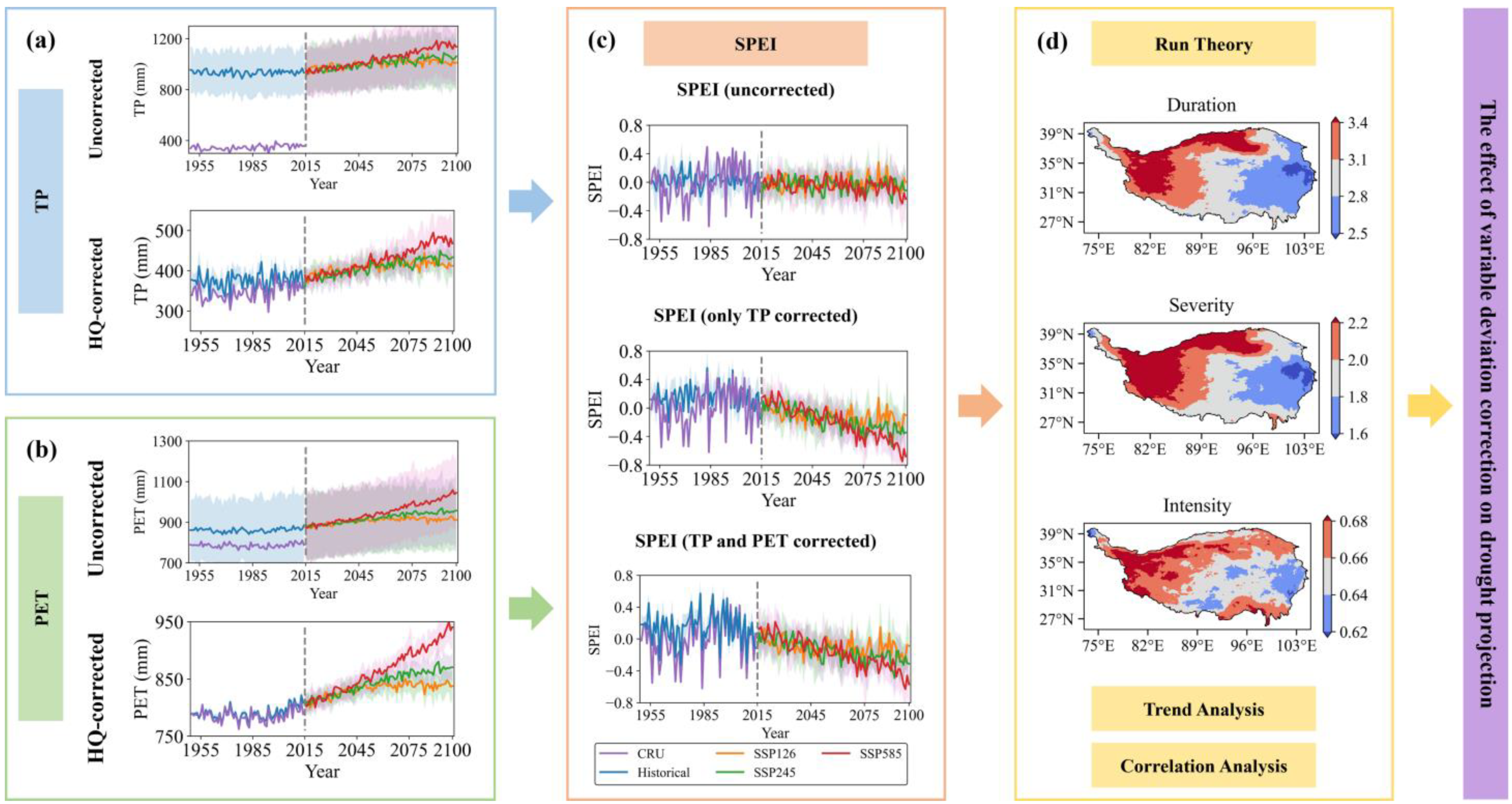
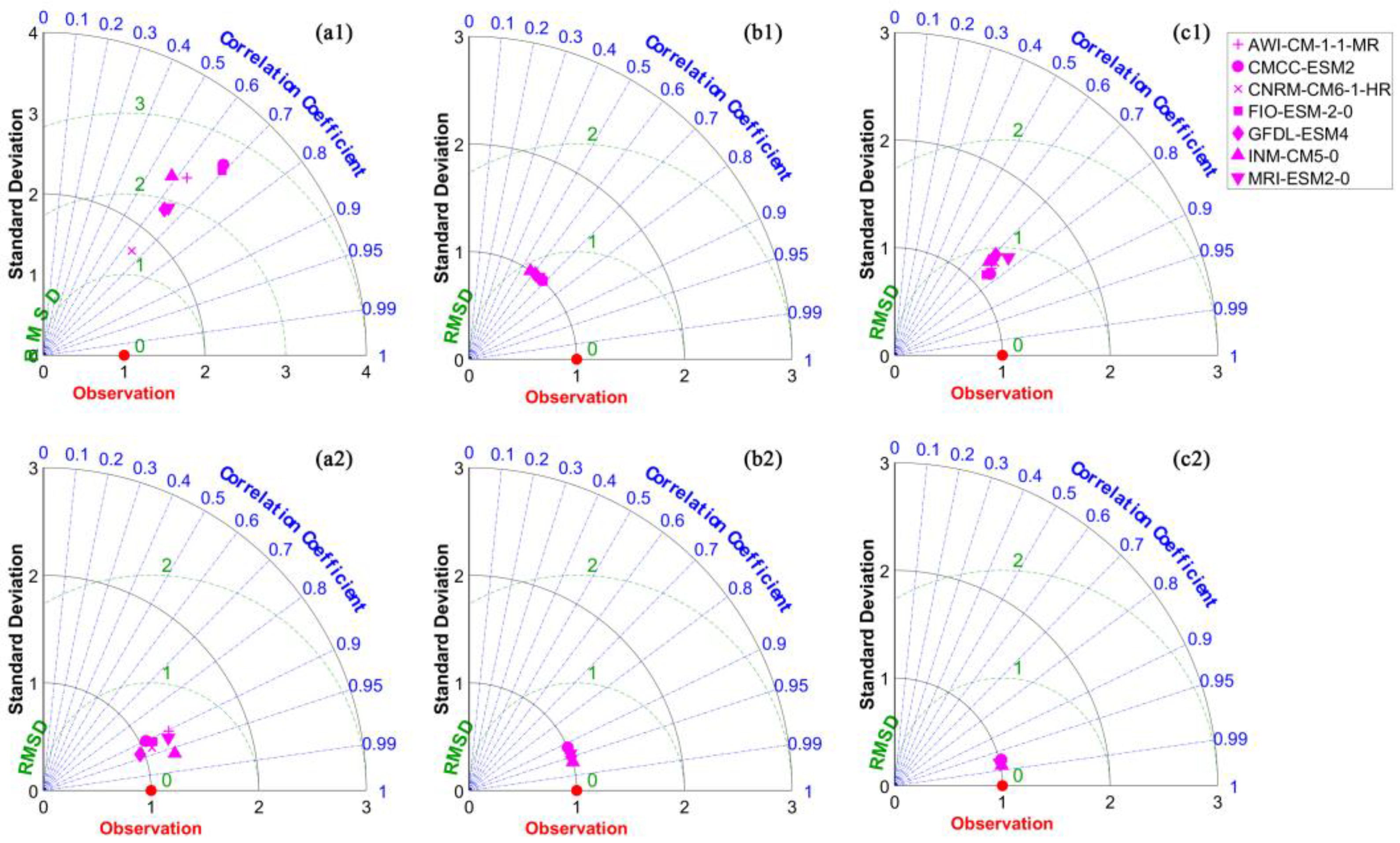
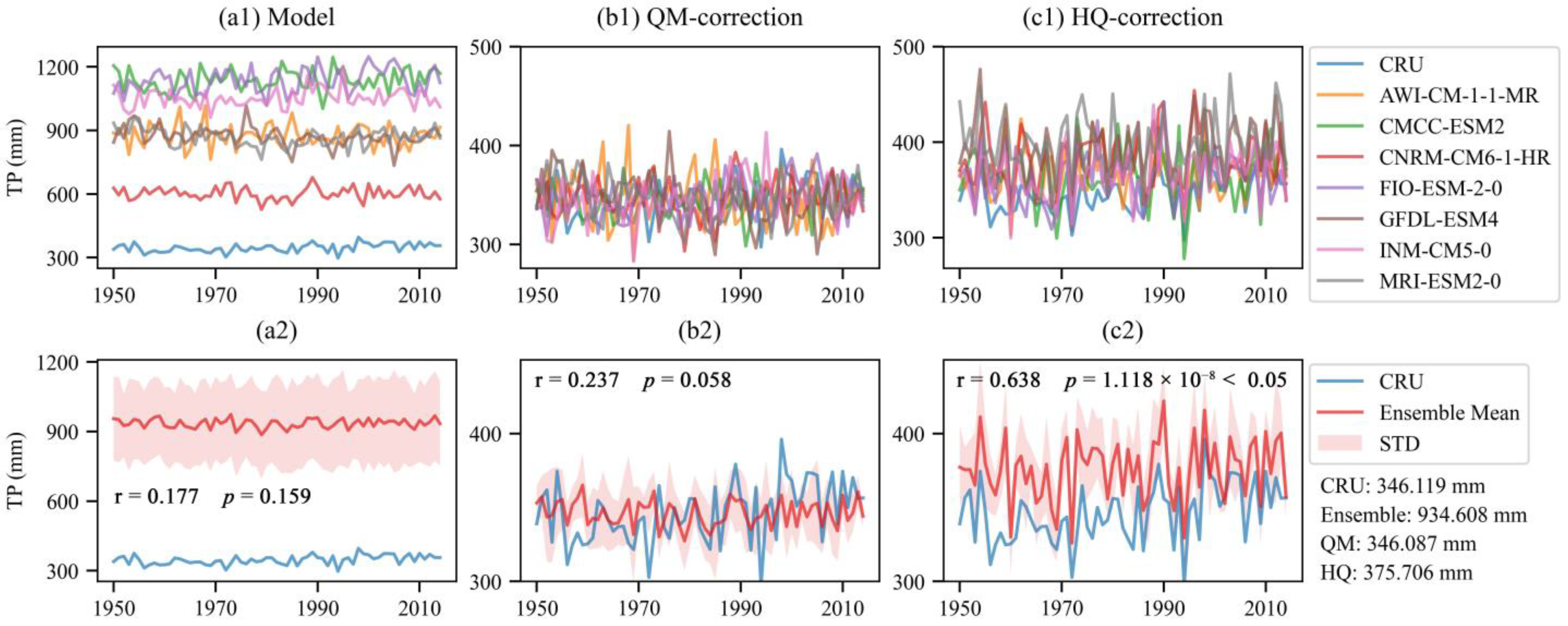
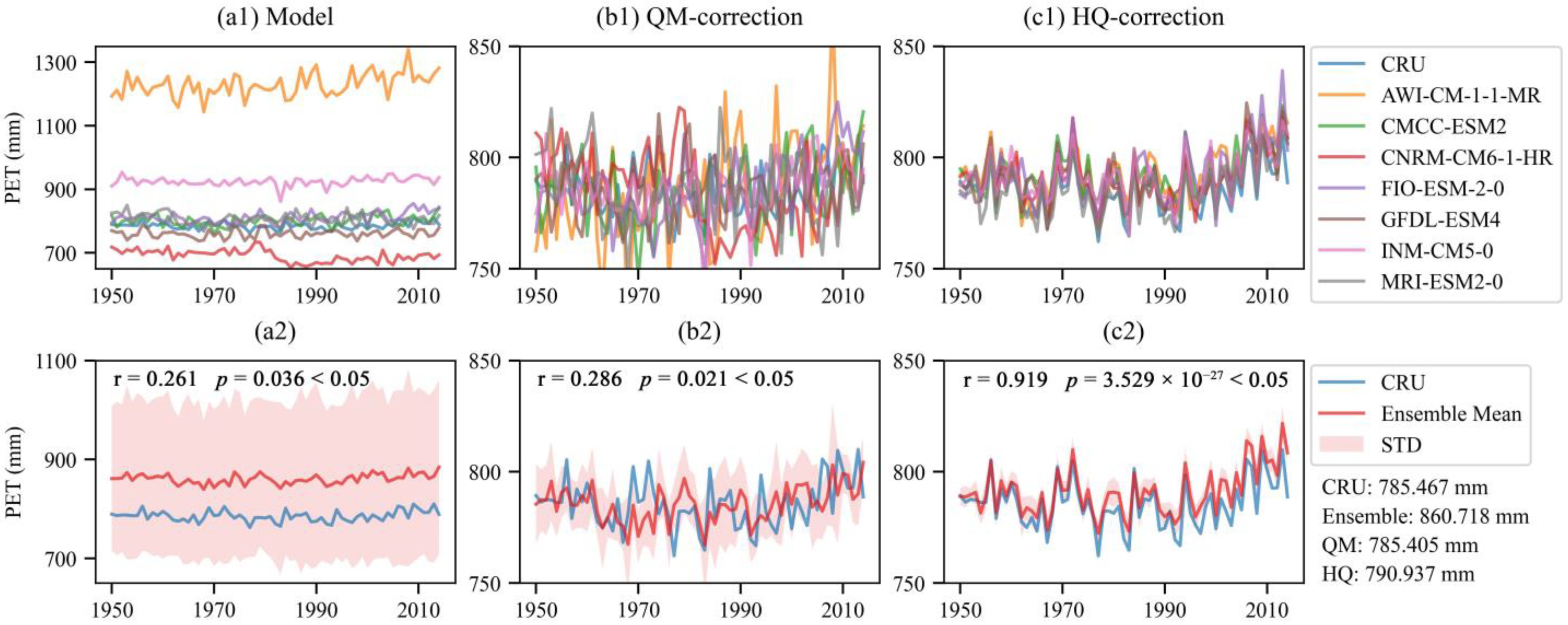


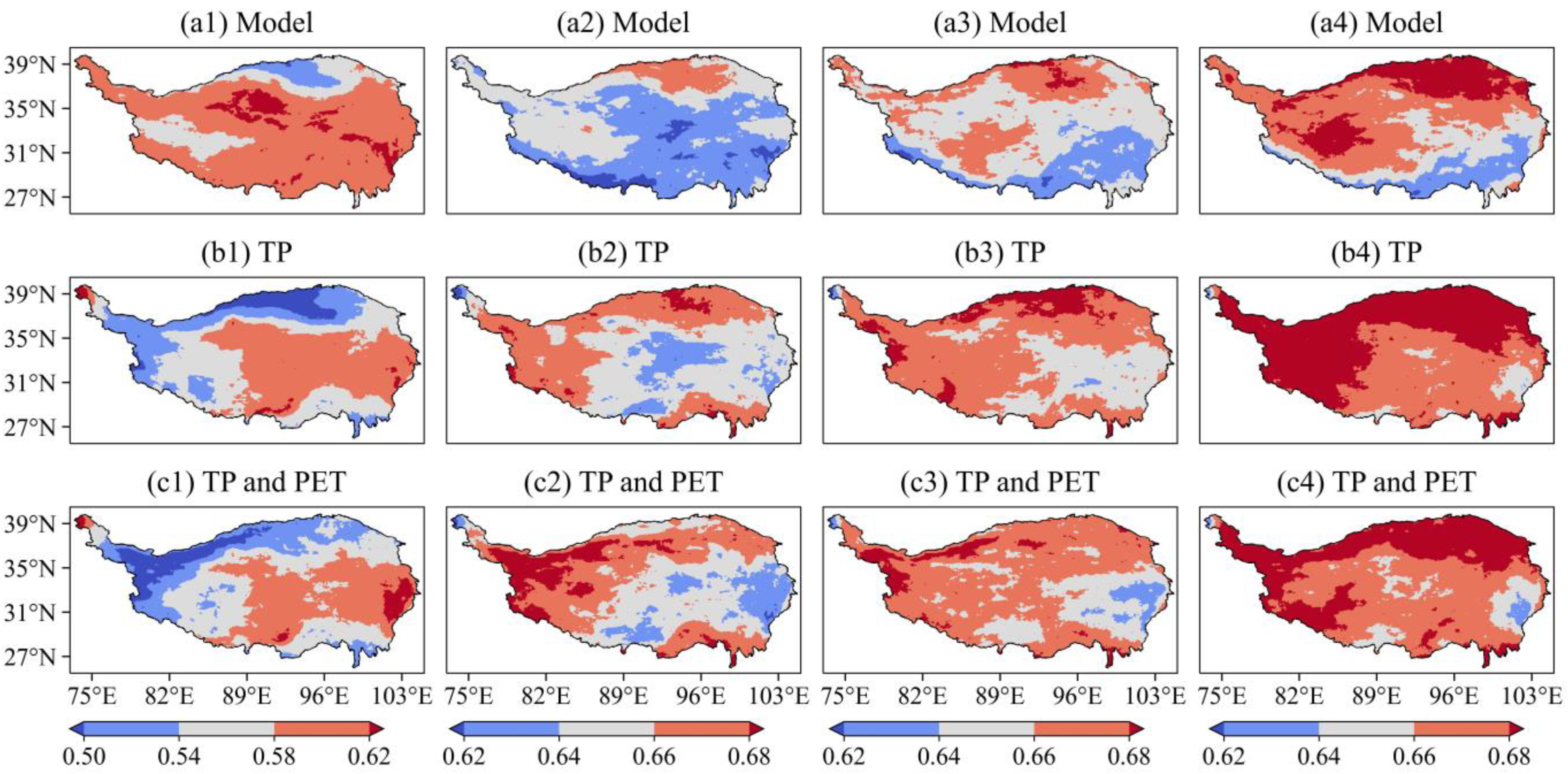
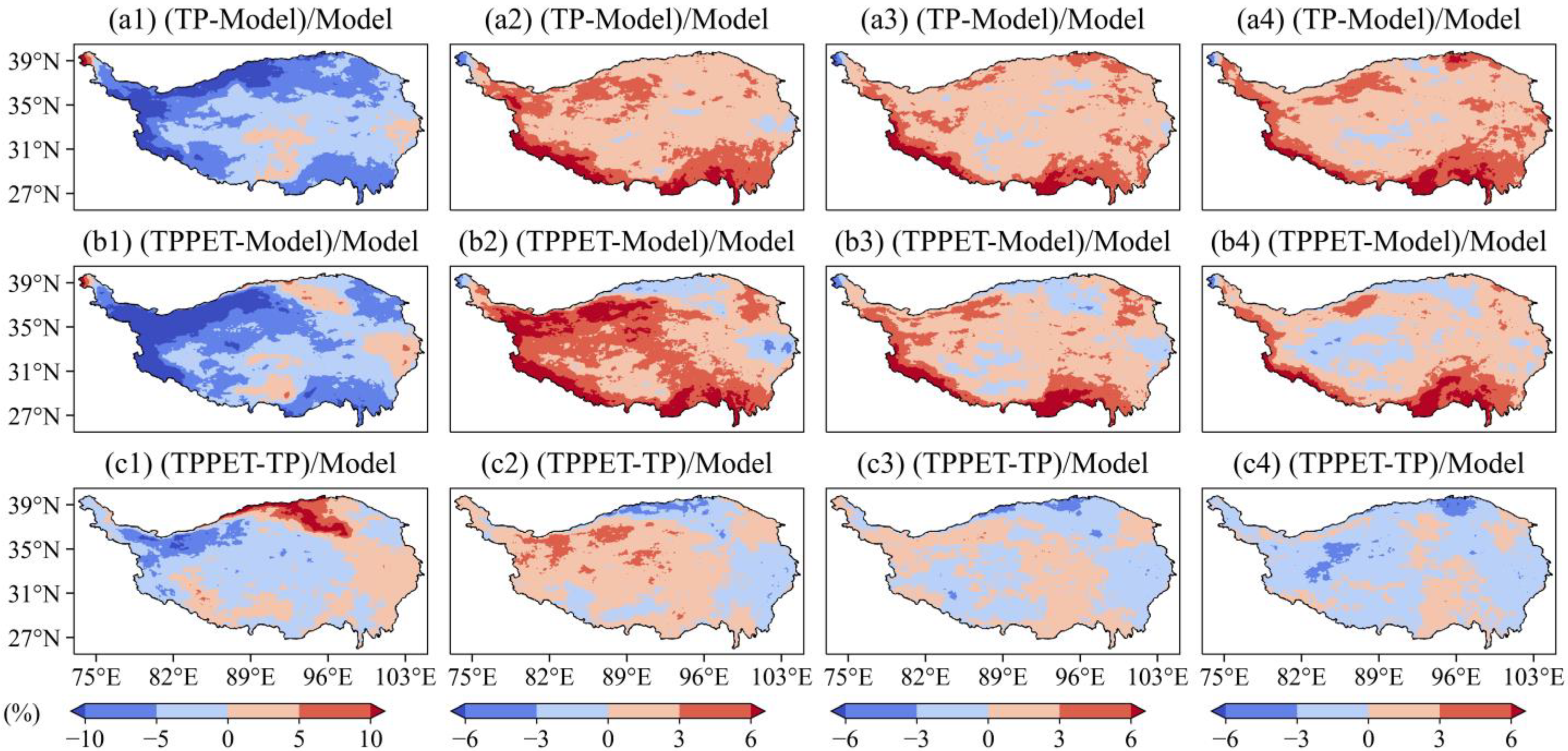


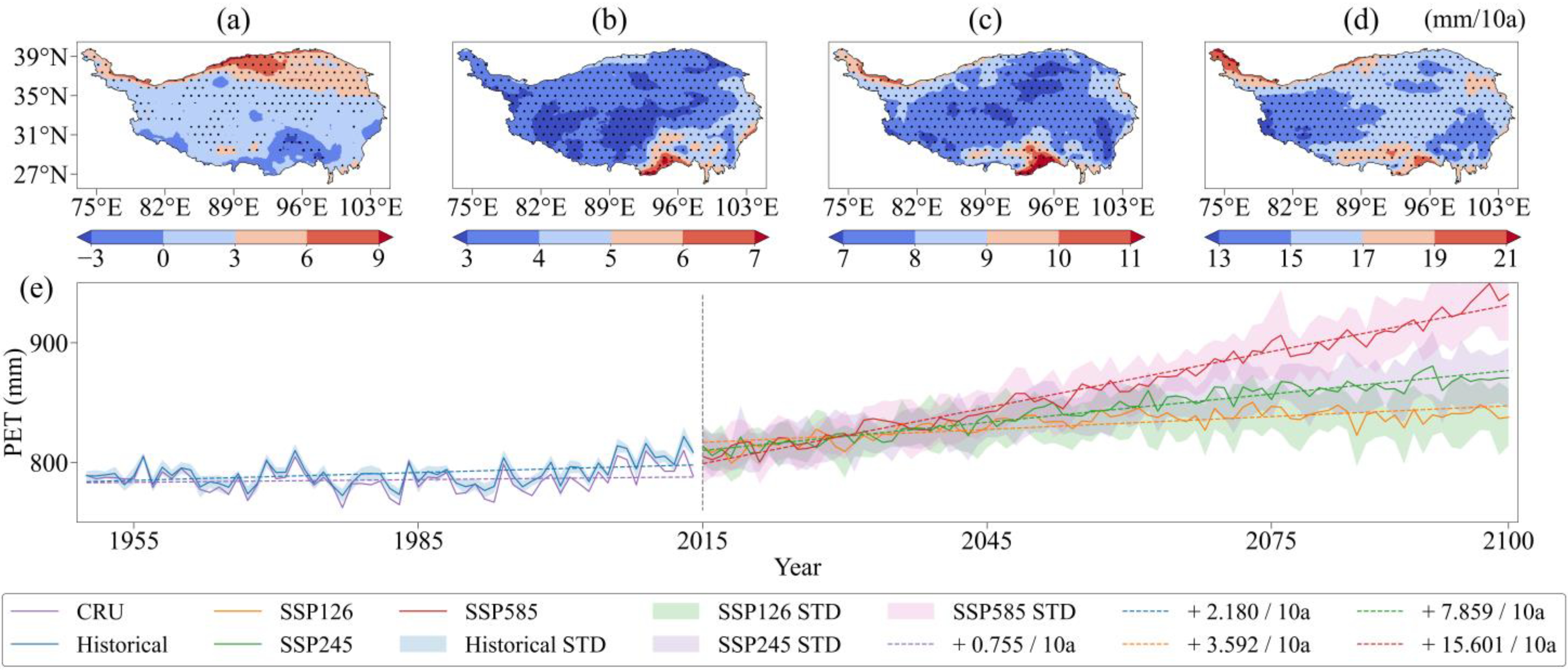
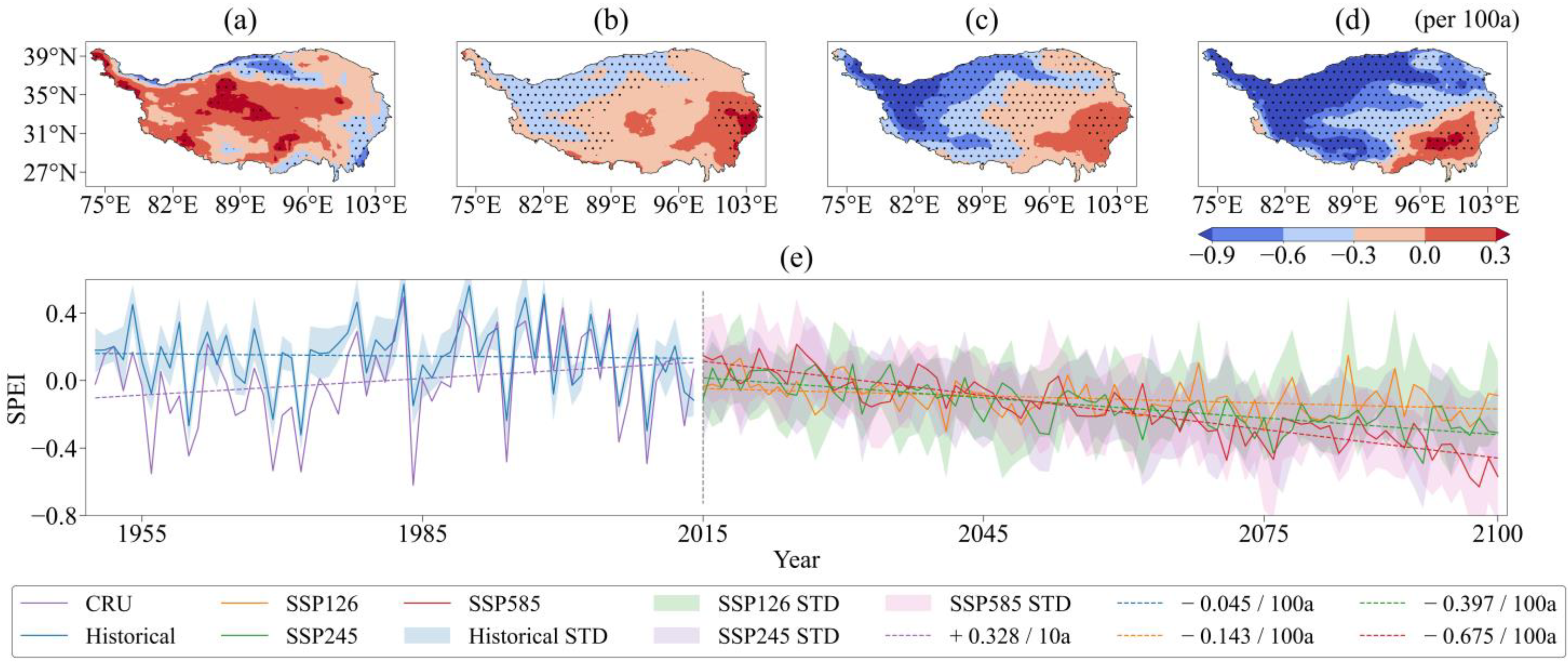
| Model | Institution/Country | Grids (lat/lon) | Resolution (km) |
|---|---|---|---|
| AWI-CM-1-1-MR | Alfred Wegener Institute, Germany | 192 × 384 | 100 |
| CMCC-ESM2 | Euro-Mediterranean Center on Climate Change, Italy | 192 × 288 | 100 |
| CNRM-CM6-1-HR | National Center for Meteorological Research, France | - | 100 |
| FIO-ESM-2-0 | First Institute of Oceanography, China | 192 × 288 | 100 |
| GFDL-ESM4 | NOAA Geophysical Fluid Dynamics Laboratory, USA | 180 × 360 | 100 |
| INM-CM5-0 | Institute of Numerical Mathematics, Russia | 120 × 180 | 100 |
| MRI-ESM2-0 | Mitsubishi Research Institute, Japan | 160 × 320 | 100 |
| TP | PET | Drought Intensity | ||||||||||
|---|---|---|---|---|---|---|---|---|---|---|---|---|
| (%) | + | R | − | R | + | R | − | R | + | R | − | R |
| SSP1-2.6 | 6.470 | 0.048 | −63.098 | 99.952 | 5.827 | 12.488 | −10.405 | 87.512 | 3.785 | 88.070 | −1.375 | 11.930 |
| SSP2-4.5 | 6.622 | 0.048 | −63.535 | 99.952 | 5.868 | 12.058 | −10.729 | 87.942 | 2.435 | 81.613 | −1.039 | 18.387 |
| SSP5-8.5 | 6.428 | 0.048 | −66.152 | 99.952 | 5.948 | 11.161 | −11.450 | 88.839 | 2.405 | 74.310 | −1.003 | 25.690 |
| Mean | 6.507 | 0.048 | −64.262 | 99.952 | 5.881 | 11.902 | −10.861 | 88.098 | 2.875 | 81.331 | −1.139 | 18.669 |
Publisher’s Note: MDPI stays neutral with regard to jurisdictional claims in published maps and institutional affiliations. |
© 2022 by the authors. Licensee MDPI, Basel, Switzerland. This article is an open access article distributed under the terms and conditions of the Creative Commons Attribution (CC BY) license (https://creativecommons.org/licenses/by/4.0/).
Share and Cite
Wang, X.; Yang, J.; Xiong, J.; Shen, G.; Yong, Z.; Sun, H.; He, W.; Luo, S.; Cui, X. Investigating the Impact of the Spatiotemporal Bias Correction of Precipitation in CMIP6 Climate Models on Drought Assessments. Remote Sens. 2022, 14, 6172. https://doi.org/10.3390/rs14236172
Wang X, Yang J, Xiong J, Shen G, Yong Z, Sun H, He W, Luo S, Cui X. Investigating the Impact of the Spatiotemporal Bias Correction of Precipitation in CMIP6 Climate Models on Drought Assessments. Remote Sensing. 2022; 14(23):6172. https://doi.org/10.3390/rs14236172
Chicago/Turabian StyleWang, Xin, Jiawei Yang, Junnan Xiong, Gaoyun Shen, Zhiwei Yong, Huaizhang Sun, Wen He, Siyuan Luo, and Xingjie Cui. 2022. "Investigating the Impact of the Spatiotemporal Bias Correction of Precipitation in CMIP6 Climate Models on Drought Assessments" Remote Sensing 14, no. 23: 6172. https://doi.org/10.3390/rs14236172
APA StyleWang, X., Yang, J., Xiong, J., Shen, G., Yong, Z., Sun, H., He, W., Luo, S., & Cui, X. (2022). Investigating the Impact of the Spatiotemporal Bias Correction of Precipitation in CMIP6 Climate Models on Drought Assessments. Remote Sensing, 14(23), 6172. https://doi.org/10.3390/rs14236172





